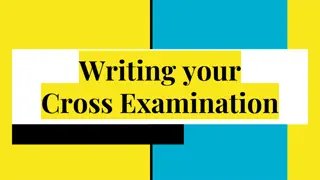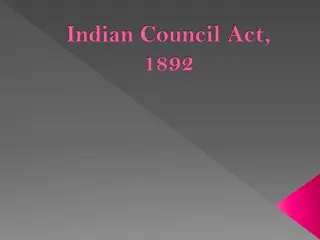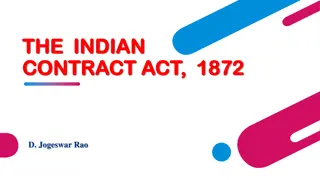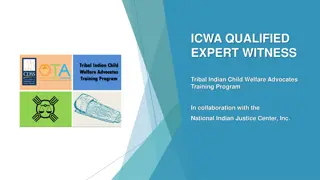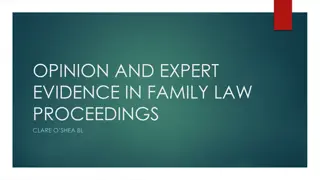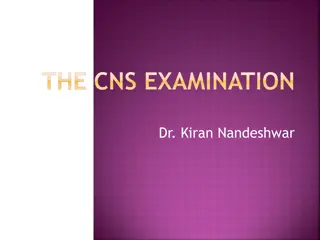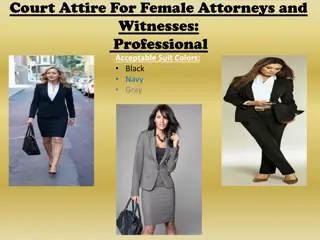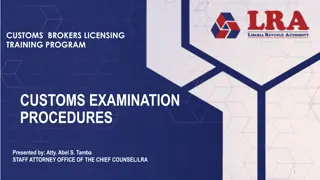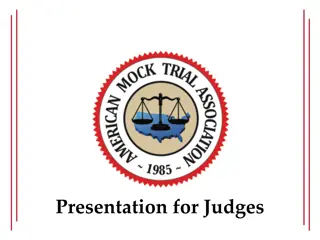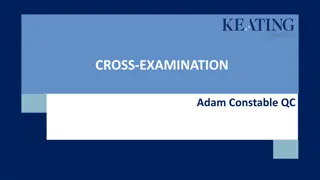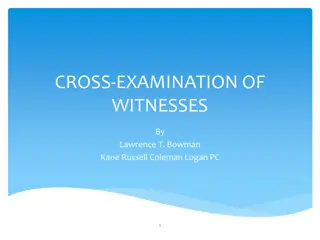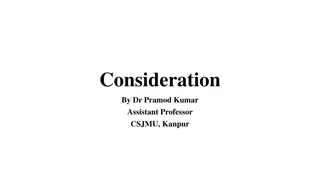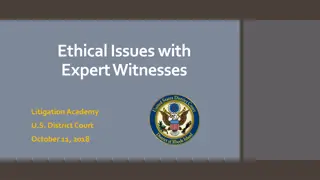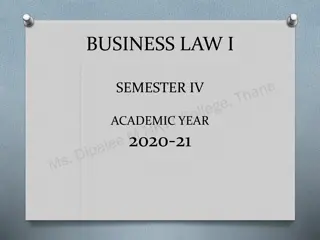Examination of Witnesses under Indian Evidence Act, 1872
Chapter X of Part III of the Indian Evidence Act, 1872, outlines the process of examining witnesses, including the order of production and admissibility of evidence. Sections 135 to 141 delve into the rules governing the examination-in-chief, cross-examination, and re-examination of witnesses, emphasizing the relevance of evidence and the sequence in which facts should be proven. The use of leading questions, the order of examination, and the role of character witnesses are also discussed.
- Indian Evidence Act
- Witness Examination
- Admissibility of Evidence
- Relevancy of Facts
- Leading Questions
Download Presentation

Please find below an Image/Link to download the presentation.
The content on the website is provided AS IS for your information and personal use only. It may not be sold, licensed, or shared on other websites without obtaining consent from the author. Download presentation by click this link. If you encounter any issues during the download, it is possible that the publisher has removed the file from their server.
E N D
Presentation Transcript
INTRODUCTION Chapter X of part III of the Indian Evidence Act, 1872 deals with the examination of a witness. Section 135 lays down the order to be followed in production and examination of witnesses which is left to be regulated by the code of civil procedure and criminal procedure. If there is no provision for a particular point in case, then, the court can exercise its own discretion in deciding the order of production of witnesses. ADMISSIBILITY OF EVIDENCE As per Section-5 of the Indian Evidence Act, 1872, only those pieces of evidence, regarding the facts and facts in issue have to be submitted that are relevant. Section 136 has reiterated this point. It states that a judge may ask the party, who has proposed to give evidence, as to how will such a fact, for which the evidence has been provided, be relevant to the case. Hence, the judge can question the relevancy of the fact for which the evidence is being provided and the evidence shall only be submitted if the judge thinks the fact will be relevant to the suit. If the fact (A) proposed to be proved, whose evidence will be admissible on proof of some other fact (B), the latter (B) should be proven first. The court, may, however, exercise its discretion and let the party prove the former (A) first, on the condition that the party will prove the latter fact (B) at a later stage. Where relevancy of an alleged fact is dependent on another alleged fact, the latter shall be proven first but again, the judge may exercise his discretion and let the party prove the first fact. It has been held Collector of Gorakhpur v Palakdhari Singh (1889 ILR 12 All 1) that any doubt about the admissibility of a piece of evidence shall be in favour of admissibility. in EXAMINATION ORDER Testimonies of witnesses are recorded as answers to the questions asked to them. These questions are relevant to the facts in issue, and such
questioning is called an examination of the witness. The evidence not only includes answers to questions but may also include statements made or that is required to be made, by the court and is relevant to the issue. Section 137 It states that a witness should be first examined by the party who has called him and this is called examination-in-chief. And when an adverse party examines the witness, it is called cross-examination. The cross- examination may explore all the relevant facts and not necessarily, the facts that were asked to the witness during the examination in chief. There might be no need for a cross-examination if the testimony is prima facie unacceptable (Ghulam Rasool Khan v Wali Khan, AIR 1978 J&K 54). If the party who called the witness, questions him, again after cross- examination, it is called re-examination. Section 138 It provides for the order of examination; a witness will be first examined in chief, and then if the adverse party deems fit, cross-examined and if the party calling him so desires, be re-examined. A witness has to be first examined in chief to be cross-examined, else, it is not permissible and not possible (Sharadamma v Renchamma, AIR 2007 Kant. 17). An order of re-examination can be made by the court on an application by the party as it is not limited to courts own motion (SSS Durai Pandian v SA Samuthira Pandian, AIR 1998 Mad. 323). The matter of re-examination should be limited to examination in chief and cross-examination and if any new matter is introduced by permission of the court, the witness can be subjected to cross-examination, again, upon that matter. Section 139 says that a person called upon to produce a document does not become a witness per se. Hence, he cannot be cross-examined, unless, examined in chief by the party who called him. Section 140 provides that witness to a party s character maybe cross- examined if already examined in chief. The evidence of character is meant to assist the court in estimating the value of the evidence brought before the court through the mouth of the witness. LEADING QUESTIONS
Section 141 Any question suggesting the answer which the person putting it wishes or expects to receive is called a leading question. A witness should tell the story relating to the relevant facts or facts in issue in his own words. If there is an inbuilt answer in the question, or if it is suggestive of an answer, a lawyer could construct a story out of the mouth of the witness which suits his client. If such a question is asked in the examination in chief or in re-examination, the adverse party may object to it. This has been provided in Section 142 and it also states an exception that such leading question may be asked on permission from the court, i.e., the objection is overruled. Section 143 states that leading questions may be asked in cross- examination. IN WRITING Section 144 Any witness may be asked, whilst under examination, whether any contract, grant or other disposition of property, as to which he is giving evidence, was not contained in a document, and if he says that it was, or if he is about to make any statement as to the contents of any document, which, in the opinion of the Court, ought to be produced, the adverse party may object to such evidence being given until such document is produced, or until facts have been proved which entitle the party who called the witness to give secondary evidence of it. Accompanied by the illustration, the section is self-explanatory: The question is whether Aassaulted B. C deposes that he heard Asay to D, B wrote a letter accusing me of theft, and I will be revenged on him. This statement is relevant, as showing A s motive for the assault, and evidence may be given of it, though no other evidence is given about the letter. Section 145
It provides that a witness may be cross-examined as to previous statements made by him in writing and if he is to be cross-examined over oral statements, which were reduced to writing, his notice shall be brought to such parts of writing before the writing is to be proved. A witness can only be contradicted over previous statements made by him, not subsequent (Mishri Lal v State of MP, 2005 10 SCC 701). LAWFULQUESTIONS Except for the questions already permitted through different sections of the act, the following questions can also be put up in cross-examination, under Section 146: To test a witness veracity or truthfulness To know who he is and what his position is in life To shake his credit by injuring his character These questions can be asked even if, directly or indirectly, the witness is criminated or is exposed to penalty or forfeiture. The witness may also be compelled to answer these questions as per the conditions of the following sections. By section 28 of the Criminal Law amendment, 2013, if a case relating to sections 376 to 376E or for an attempt to commit any such offence (under the Indian Penal Code, 1860), the victim s moral character or previous sexual experience cannot be questioned in cross examination. COMPELLED TOANSWER Section 132 provides for compelling of a witness to give answers to the question that are relevant to the matter in issue. This cannot be excused on the ground that such answer would give rise to witness liability, criminal or civil. If the witness is forced to give an answer, the same shall not be used as evidence against him in any case, provided, the evidence so provided was not false. Section 147 provides that if any such lawful question is relevant to the suit or proceeding, the provisions of section 132 will apply. Section 148 provides protection against aggressive cross-examination. If a person s character is in question, to shake his credit, the court may, while exercising its discretion, warn the witness that he is not obliged to answer. Provided the court considers the questions that were asked were irrelevant to prove his credibility or far too remote in time or those which would not
affect at all or slightly affect the witness credibility as to the matter to which he is giving evidence. REASONABLE GROUND Section 149 provides that if there is no reasonable ground to convey an imputation under section 148, the questions are not to be asked. This section also safeguards a witness against damaging of character. Illustration (c) to this section makes it clear: A witness, of whom nothing whatever is known, is asked at random whether he is a dacoit. There are here no reasonable grounds for the question. Section 150 lays duty of a counsel in questioning a witness character. If a barrister, pleader, vakil or attorney questions a witness character without a reasonable ground, the same shall be reported to the High Court or any authority to which he is subject. QUESTIONS FORBIDDEN Section 151 confers the court with the power to forbid questions that are indecent and scandalous. These questions might be related to the matter in hand and may only be allowed if they relate to the fact in issue or are necessary in determining whether some fact in issue existed. Section 152 empowers the court to forbid questions that are meant to insult or to annoy. Even if the question might be proper, the court can reject it if it is needlessly offensive. SECTION 153 It provides for protection of a witness character. If a witness has answered a question as to his credit, no evidence shall be admissible to contradict his answer. This section has two exceptions, first, if he lies about his former conviction and second, to impeach his impartiality; evidence may be provided to contradict both these claims. Though no evidence is admissible to contradict a witness claim as to his credit, if the witness has lied, he can be separately charged for producing false evidence. SECTION 154
It allows for the party, who has called upon a witness, to put up any questions to the witness as could be asked to him during cross- examination. This section brings under its purview, the concept of a hostile witness. It has been defined by the Supreme Court in Sat Paul v Delhi Administration (AIR 1976 SC 303), as one who is not desirous of telling the truth at the instance of the party calling him. The previous testimony of a hostile witness is not washed off, the court can use it as evidence and if the prosecution does not confront the witness, regarding the contradiction, it shall be the duty of the court to do so for ascertaining truth (State of Rajasthan v Bhera, 1997 Cr LJ 1237). SECTION 155 The credit of a witness can be impeached in the following ways. It is usually impeached by the adverse party but if the witness becomes hostile, his credit can be impeached by the party who called him: By producing witnesses who testify from their personal knowledge of the witness that such person is unworthy of credit. The produced witnesses must have personal knowledge of the witness they are testifying against. By showing that the witness was bribed or has taken an offer to receive a bribe or has some other corrupt inducement. By citing earlier statements of the witness which contradicts him, only to the extent which section 153 permits. CORROBORATION OF EVIDENCE Section 156 provides that a witness circumstances, apart from the main event, with the intention to corroborate evidence provided by him and the court shall permit it if it deems that these questions will help corroborate his testimony in reference to the relevant facts. Section 157 states that a former statement of a witness can be used to corroborate testimony of the witness in relation to a common subject matter. In Rameshwar v State of Rajasthan (1952 SCR 377), the Supreme Court allowed the statement of a young girl who was raped, to be may be questioned about
corroborated with the girls own statement to her mother four hours after the incident. Section 158 says that statements relevant under section 32 or 33 (like, a dying declaration), that have been proved, all matters which confirm or contradict the statement, can be proved. Evidence can also be given to impeach the credit of the person who made such statement, to the extent as if that person had appeared as a witness. REFRESHING MEMORY A witness is allowed to refer to a writing made by him either at the time of happening of an event concerning which he is questioned or sometime later, which the court considers it likely that the event was fresh in his memory. The witness can also refer to someone else s writing about the event which was made within a time period which court considers reasonable on the ground stated above. If the witness is an expert, he may consult professional books. These provisions have been provided under Section 159. Section 160 Awitness may testify to facts mentioned in such document as is mentioned under section 159. It does not matter whether the witness has any specific recollection of the facts recorded, as long as he is sure that he correctly recorded them. Section 161 gives a right to the adverse party to cross examine the witness and also to produce to him any such writing, as given under section 159 & 160. PRODUCTION OF DOCUMENTS When a witness has been called upon to produce a document, he is bound to produce it. Any objection to it shall be dealt with by the court and to determine its admissibility, the court shall inspect it, except when it refers to matters of state (Section 162). Section 163 requires the party (A), who has given notice to the other party (B) to provide certain documents, to produce such documents after initial inspection in the court, as evidence if the party (B) asks so. Section 164: If, under the previous section, party B denies to provide A with the required documents, the same cannot be produced in court by B withoutA s permission.
SECTION 165 This section provides for the power of court to question. A judge can, in order to obtain proof of relevant facts, ask any question he pleases, be it relevant or irrelevant to the case. It may be asked any time and may take any form and be directed at a witness or a party. The judge can though, not compel the witness to answer and the judgement should be based upon the facts which have been declared relevant under the IEA. CONCLUSION While safeguarding the social life of a witness, the act serves justice to the fullest extent. By omitting and adding certain provisions, the act is indeed keeping up with the modern times.




